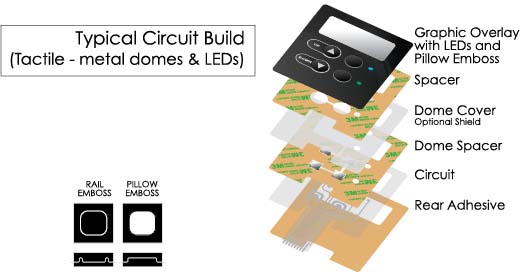Top Features to Look for in a High-Quality Membrane Switch
Top Features to Look for in a High-Quality Membrane Switch
Blog Article
Recognizing Membrane Layer Switches: The Secret to Trusted and sturdy Controls

What Are Membrane Switches?
Membrane buttons are a sophisticated remedy in the world of user interface innovation, incorporating functionality and design flawlessly. These gadgets function as an interface in between users and electronic systems, integrating numerous components right into a small layout. Commonly created from flexible, slim layers of materials, membrane switches are made to react to touch, allowing individuals to engage with machinery and digital devices efficiently.
The primary elements of a membrane button include a printed circuit layer, graphic overlay, and a spacer layer that avoids unplanned activation. The graphic overlay can be tailored to mirror brand identification or individual choices, improving appearances while making certain functionality. Membrane switches are commonly utilized in different applications, including medical tools, consumer electronics, and commercial equipment, owing to their longevity and resistance to ecological aspects such as moisture and dirt.
Among the vital advantages of membrane switches is their capability to hold up against wear and tear, making them excellent for high-traffic settings. Additionally, they are lightweight and require marginal room, permitting innovative layouts in item advancement. Overall, membrane layer switches over represent a useful and reliable selection for modern-day digital user interfaces, weding modern technology with user-centric design concepts.
Just How Membrane Layer Changes Work
The procedure of membrane layer switches joints on a basic yet effective system that converts customer input into electronic signals. When an individual presses the button, the top layer warps, enabling a conductive component in the circuit layer to make call with an equivalent conductive pad on the bottom of the graphic overlay.
The style of membrane switches can differ, however they typically integrate domes or tactile aspects to offer comments to the user, enhancing the total experience - membrane switch. The materials utilized in membrane layer buttons, such as polyester or polycarbonate, contribute to their sturdiness and resistance to environmental aspects, including moisture and dirt. Moreover, the printed circuits are commonly encapsulated, which protects them from deterioration gradually.
Advantages of Membrane Switches

Furthermore, membrane layer go to my blog buttons are recognized for their durability. Created from robust products, they are resistant to dirt, dampness, and physical wear, which considerably expands their life expectancy compared to traditional mechanical switches. This toughness makes them specifically suitable for high-traffic atmospheres and applications requiring longevity.
One more significant benefit is the ease of cleaning and upkeep. The smooth surface area of membrane layer switches lessens dust buildup and is often unsusceptible spills, making them perfect for setups that call for frequent sanitization.
Furthermore, membrane layer buttons use a structured account, causing a thinner design that can be incorporated into different gadgets without including mass. This feature not only enhances the aesthetic appeal but also adds to a more ergonomic item style.
Applications of Membrane Layer Buttons
Versatile and user-friendly, membrane buttons locate applications across a wide variety of markets, consisting of clinical devices, customer electronic devices, and industrial tools. In the clinical field, these official website buttons are essential to gadgets such as analysis devices, patient surveillance systems, and mixture pumps, where dependability and convenience of cleaning are important. Their capacity to keep and hold up against severe environments performance makes them ideal for such applications.

In customer electronic devices, membrane buttons are made use of in products like microwaves, washing devices, and push-button controls - membrane switch. Their sleek style permits intuitive interface, improving the overall individual experience while providing durability and resistance to tear and use
Industrial tools likewise takes advantage of membrane switches, specifically in control panels for equipment and automation systems. These buttons provide defense versus dirt and moisture, making certain consistent efficiency in difficult settings. Their adjustable functions enable manufacturers to customize them to certain operational demands, boosting efficiency and capability.
Choosing the Right Membrane Layer Switch Over
When choosing a membrane button, it is necessary to take into consideration various aspects that influence performance and suitability for details applications. The main considerations include ecological problems, tactile feedback, sturdiness, and style specs.
First, evaluate the operating setting; switches exposed to dampness, chemicals, or severe temperature levels call for specific materials to make certain longevity and functionality. Next off, assess the demand for tactile responses. Relying on individual interaction, some applications might take advantage of a tactile reaction to verify activation, while others might favor a non-tactile design for aesthetic reasons.
Longevity is another critical aspect; membrane layer switches need to be made to endure constant usage, effects, and abrasion. Make certain the chosen switch can withstand the anticipated lifecycle, especially in high-usage situations.

Verdict
In final thought, membrane switches offer as crucial elements in the style of trusted and durable control more helpful hints systems across numerous industries. The flexibility of membrane layer switches enables for tailored remedies that meet particular functional needs, strengthening their importance in contemporary technology.
Membrane layer changes stand for an essential element of modern user interface design, mixing capability with resilience in various applications.Membrane layer buttons are an innovative solution in the world of individual interface technology, integrating functionality and style perfectly. Typically constructed from adaptable, slim layers of products, membrane buttons are made to react to touch, enabling customers to connect with machinery and electronic devices properly.
The style of membrane switches can differ, yet they usually incorporate domes or tactile elements to provide responses to the individual, boosting the overall experience.In verdict, membrane switches offer as important components in the style of trusted and resilient control systems throughout different sectors.
Report this page